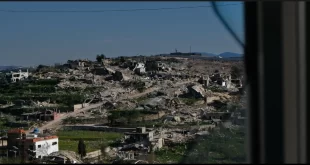May 14, 2015, What’s Left
By Stephen Gowans
The New York Times ran an article on May 12 suggesting that the Syrian government has held back some of its chemical weapons and is using them against rebel fighters. Significantly, the allegation was backed by no evidence, yet the newspaper chose to run the story anyway.
In their story (“Inspectors in Syria find traces of banned military chemicals”) reporters Somini Sengupta, Marlise Simons and Anne Barnard cited a conclusion drawn by an anonymous Western diplomat who was briefed on findings by inspectors from the Organization for the Prohibition of Chemical Weapons. The inspectors had reportedly found traces of toxic nerve agents in Syria. The diplomat was quoted as saying that there’s a “strong suspicion” that the Syrians “are retaining stockpiles which are being held back.”
However, a close reading of the article showed that there was not one whit of evidence to back up the diplomat’s suspicion. Indeed, at various points in the article, the story’s lead was challenged by the journalists themselves.
• “[S]mall amounts of banned agents [have been found. But these findings] do not necessarily indicate a lingering weapons program.”
• “[T]here was no clear evidence of new use or production of forbidden chemicals.”
• “There is no evidence that banned materials were used in weapons after Syria signed the treaty, or that Syria possesses sufficient quantities to use in future weapons.”
A fitting headline would have read “Western diplomat accuses Syrian government of hiding chemical weapons, on no evidence.”
In the same article the reporters refer to “mounting evidence that Mr. Assad’s forces had violated the terms of the international treaty banning use of chemical weapons … by dropping jerry-built chlorine bombs on insurgent-held areas.” The mounting evidence turned out to be the testimony of witnesses who say the bombs have been dropped from government helicopters.
However, the quality of the evidence is untested, and virtually useless. There’s no way to determine whether the witnesses are authentic or simply opponents of the Syrian government who have an interest in spreading false allegations.
What’s more, there’s a compelling reason to believe that Syrian forces have not engaged in the action they’re accused of. Jerry-built chlorine bombs are capable only of briefly incapacitating a few fighters. Conventional bombs—which the Syrians have in abundance—permanently eliminate many more. Why, then, would Syrian forces risk worldwide condemnation to use an ineffective weapon, when they have more effective weapons at their disposable which world opinion does not condemn?
Sensing that their source’s allegation may be treated with suspicion, the New York Times journalists acknowledge that “Evidence of chemical weapons remains a fraught issue for global public opinion more than a decade after false claims of an Iraqi chemical weapons program were used to justify the American invasion that deposed Saddam Hussein.”
No less fraught is the complicity of Western media in propagating similarly baseless allegations to serve an obvious political agenda.
SEE RELATED: Chemical Fabrications: East Ghouta and Syria’s Missing Children, Prof. Tim Anderson Global Research, April 12, 2015
 Syria Support Movement solidarity with the Syrian people
Syria Support Movement solidarity with the Syrian people




